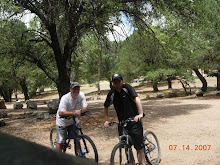
So, today the tunnel work continued (as if you couldn't tell that from the title) and it is a slow and tedious process. Last time I worked on it, I had started gluing down the track bed (black foam that the track sits on) to the foam risers. So, with that accomplished I set about re-pinning the track to the track bed to make sure everything was still stable. It wasn't. There were three or four areas where the track didn't stay on the bed and a couple areas where the bed wasn't staying connected to the risers. So I repositioned everything that was out of place and connected the track again. I made sure all the track connections were really tight. Apparently, this is key to a smooth ride for the trains, which makes complete sense. Actually, after going through all of this just to make sure the track is smooth, it makes me wonder how my other trains have ever even managed to stay on the track... but it does explain why they gave me such trouble, too. Anyway, with the track freshly pinned to the bed, I was ready to start gluing the track to the bed. This is a moment I've been dreading. I have other moments I'm dreading, but this was the first one to arrive. I've been dreading it cause I know I'm gonna screw it up. Seriously, anyone who has known me for more than a week, knows how not handy I am. Handsy, yes; handy, no! So the idea of gluing things in place and getting everything to line up right, so on and so forth had me a bit nervous.
I decided to tackle the problem systematically. I took the first three track pieces on one side off, after marking with pins exactly where they went. Then I laid down the glue for the first piece. The instructions say "an even level of glue," which means nothing to me. An even what? So I started off erring on the side of caution and using very little. Which meant I had to pull up the track and add more glue, of course. Anyway, after gluing down the first piece I pinned it in place, and then glued the second piece and pinned it down. Next, I took the fourth piece off the track bed and then glued down and pinned the third piece. And on and on ad nauseam, until all the track in the tunnel portions was glued down and re-pinned. After a few pieces, it got much easier and I got a lot more comfortable with the "level" of glue required. As I added each piece I ran a boxcar over each connection, including testing the switch tracks to ensure it was smooth. It is! In fact, in a couple of areas where the connection was slightly off, I added shivs to make them even. Me! Adding shivs... It may not be funny to you, but it's down right hilarious to me. Anyway, once the glue dried, I pulled the pins from the track and tested it again. It is a thing of beauty! All things considered, of course.



So the next step is to lay the ballast. Ballast, if you don't know, is the dirt between the railroad ties. It makes them stable (in real life) and in model trains it covers up the track bed too! So, the directions state I'm supposed to "brush the scenic cement (provided) onto both sides of the track bed." Dang! A new snag. So, the problem is that when I assembled the entire track and tested it and all, it didn't exactly line up with the risers, exactly centered on the risers, I should say. I didn't see this as a problem, cause I knew the track bed was going to be on top of the risers anyway, so if the track came to the edge of the track bed, who cares? Well, now that I look at it, I do. You see, the track bed is designed so that the track runs smack dab down the center of it, and there is space on both sides to make it look like a realistically raised track. So, if it goes all the way to the edge, it won't look realistic. So, my only comfort at this point is that everything I'm currently working on, is going to be inside the tunnels, so I can make my mistakes there and have it right for the parts that will be seen. I also realized that my craftsmanship is going to have to be a lot better in cutting the track bed to look realistic. The shoddy work I did on the tunnels just won't cut it. Well, I still have a ton of gluing and ballasting to do for the tunnel areas next time, so I'll let you know how that goes.





















